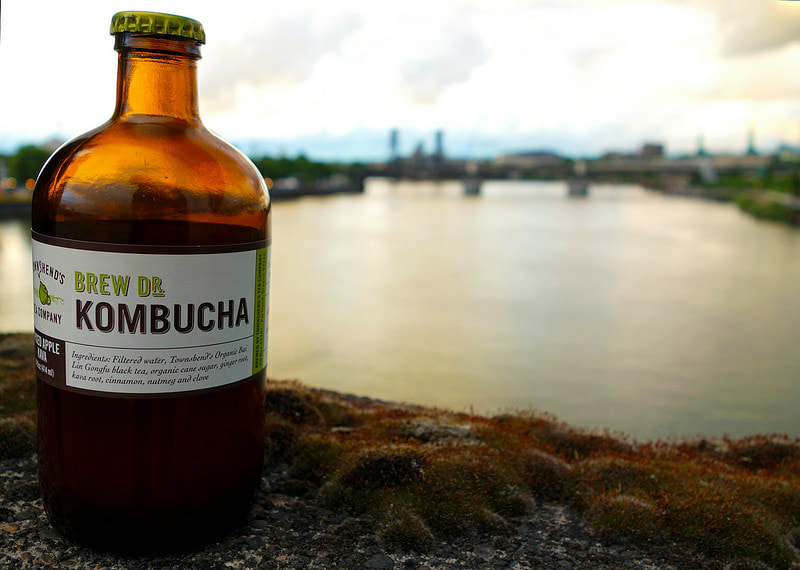How to Make Herbal Kombucha (During 1st Ferment)
Jan 08, 2019
“80% of your immune system lives in your gastrointestinal tract and probiotics can help. Approximately 500 different species of bacteria live inside you. The weight of these bacteria is about two to three pounds.” Institute of Health Sciences.
What we eat and drink directly affects our immune system by way of our intestinal health. We truly are what we eat (and drink) and the quality of that food and drink has a huge impact on our immune system. There could be no truer quote regarding food and medicine than that from Hippocrates, “Let food be thy medicine, and medicine be thy food.”
Kombucha, a fermented tea packed full of probiotics (good bugs for the gut) can attribute to making sure your gut is getting what it needs and in turn your immune system what IT needs. Adding herbs and spices to that mix just adds to the healthful affects on the body. Whether you are flavoring your first fermentation with herbs or the second fermentation, adding herbs and tisanes (herbal teas) will open up the flavor possibilities as well as the benefits of drinking kombucha.
A quick note! This post may contain affiliate links. Read more about what that means here.
If your new to brewing kombucha at home and need a little run down on the 101, my friend Michelle has a lovely post on how to get started with the yumminess of kombucha! If you have brewed kombucha before and are looking for a bit of an advanced brew this post is for you!

Camellia Sinensis vs Tisanes
What is a tisane exactly? A tisane is another name for an herbal tea. This would cover all teas that are free from leaves of the camellia sinensis plant.
Camellia sinensis is the scientific name for the actual tea plant that black, green, white, pur’erh, oolong, teas come from. All of these teas originate from the same plant. The different flavors and names come from the form of processing and the way the plant is treated post harvest.
With a tisane, the “tea” is blended using different herbs and botanicals. Plants such as lemon balm, mint, spearmint, peppermint, chamomile, rose petals. A tisane may also have things like citrus peels (orange, lemon, lime) or roots like dandelion, chicory, ginger, turmeric. Or barks such as cinnamon. Maybe even fruits such as elderberry, strawberries, peaches, aronia, haskap, blueberries, blackberries or raspberries. Essentially a tisane/herbal tea is a tea void of camellia sinensis, at least in it’s purest sense.
Now sometimes the two are blended together, say in the case of our Persnickety Peach Chai with a black tea base and a host of tisanes and fruits for flavor.
Why Brew Kombucha With Herbs?
Why would we want to brew our first ferment of kombucha using herbs and not just tea (camellia senensis)? There are a few reasons that you might want to add herbs, botanicals and fruits to your list of first fermentation ingredients.
#1 Tisanes/ Herbs Add Flavor and Variety
One of the biggest reasons to add the herbs and tisanes the first time around is that it simplifies the process of making kombucha by flavoring your brew the first time rather than having to flavor during a second ferment.
If you are looking for a more subtle, well meshed mouth feel this is the way to go. With a longer brew time the first time around the herbs/tisanes used are going to have a deeper flavor. This flavor will be much different from the one you will get when adding these herbs to the shorter second fermentation time. Compare using herbs and botanicals in your first ferment to the difference in flavor when you cook a roast long and slow in a crockpot vs the stove.
#2 Added Health Benefits when using Tisanes/Herbal Flavorings
Any time you use an herb, botanical or fruit you are going to get the benefits of each that is used. Adding those benefits to a fermented food is only going to compound the benefits of each herb/botanical.
A study done in October of 2018 shows that, “antioxidant and antimicrobial activities of kombucha can be increased by adding medicinal plants, especially at higher concentrations.” Also in adding herbs to the beverage that you are already consuming helps to increase the amount of herbs (and their benefits) that you are getting in your daily diet.
Adding herbs and botanicals to your kombucha brew, like say turmeric, can also help you get the anti-inflammatory, anti-oxidant and other benefits of turmeric in a tasty way. I would much rather drink a glass of refreshing ginger/turmeric kombucha than pop a capsule of turmeric any day!
One study has shown that using oak leaves in your kombucha blend may reduce inflammation in the body and help to decrease oxidative stress. Brew Dr. Kombucha makes a 1st ferment blend with oak in it that tastes similar to a cream soda.
#3 To make a Caffeine Free Kombucha Brew
It is possible to use tisanes in place of ALL cameilla sinensis tea when brewing your first ferment. Another study shows that lemon balm was an acceptable decaffeinated replacement for cameilla sinensis when brewing during the first ferment. Not only is a possible to use an herbal tea to brew kombucha but the same study shows that lemon balm kombucha, “ exhibited higher antioxidant activities compared with C. sinensis L. and M. officinalis L. infusions.”
Adding cinnamon to your first fermented kombucha brew can increase the antioxidant content and antimicrobial content. Studies were done using 25%-100% cinnamon concentrations.

Will Herbs and Tisanes Affect the Health of My Scoby?
The above studies would seem to answer this question scientifically. Cinnamon, oak leaf and lemon balm are obviously safe to brew in a first fermentation and may even help the health of the scoby as well as increasing the benefits to the kombucha drinker.
There are differing opinions by other popular kombucha brewers on the web though:
Kombucha Kamp notes that a healthy scoby needs certain nutrients from the teas or herbs used including nitrogin, tannins, polyphenols and others. While some herbs may not contain one or all of these it is possible to combine herbs and or mix herbal teas with black or green teas to make a flavored ferment during the intial fermentation stage.
Another trusted source, Cultures for Health, recommends that herbal teas be used with at least 25% black or green tea. Noting also not to use herbal teas that have added flavorings or oils in them.
So why the discrepancy?
Here are my thoughts: There are two main reasons that herbal teas are said to not work during a first kombucha ferment.
1.) The herbs/botanicals do not have tannins or enough tannins to feed the fermentation process in the long term. Thus it is easier to use a blanket statement that herbal teas don’t work than to list the ones that do and do not.
Some herbs and foods that DO contain tannins are:
Apples, blueberries, blackberries, strawberries, raspberries, cranberries, cherries, pineapples, lemon, lime, oranges, grapefruit, guava, cantaloupe, honeydew chocolate, nuts, rhubarb, blackberry leaf, clove, tarragon, cinnamon, thyme, peppermint and chamomile.
As you can see many of the items that might be used in herbal tisanes/teas contain tannins though in lower amounts than camellia senesis (black/green) teas.
2.) Many herbal teas are flavored with extracts, oils and synthetic flavorings.
It is a rare thing to find an herbal or flavored tea that is NOT flavored with essential oils, other oils, extracts and/or synthetic flavorings. These items will affect the health of your scoby and kombucha brew. These are not items that you want in your steeping process at all. It is easier for most companies to suggest that herbal teas do not work in kombucha rather than source and or find teas that do not contain these items.

How to Make Kombucha with Herbal Teas
What is a home kombucha brewer to do then? The science says many herbs contain tannins, which the kombucha needs to ferment the tea and for the health of the scoby. The science says that fermentation makes many of these herbs more beneficial to our bodies. Yet popular sites suggest we stay away from making kombucha with herbal tea.
Inspired by one of my favorite local kombucha brewers, who sell kombucha ready-to-drink, I steep my kombucha similar to how they steep theirs. Brew Dr. Kombucha is an Oregon based company who has grown exponentially over the last few years. They are one of the few ready to drink kombucha manufacturers who not only flavor their teas during the first fermentation but they also use herbal tea blends to do it. Their process involves mixing a black or green variety with the herbals to flavor it during the first fermentation. Their example shows that brewing herbs with the first fermentation works on a large scale and would certainly work at home.
The Solution
This brings us to how we go about brewing herbal kombucha in our own home kitchens.
There are really three options:
1.) All-Herbal Kombucha Brew
Using a spare scoby (because all good experimentation has a back up plan, or two or three). Brew a batch of kombucha with your favorite herbal tea. Making sure it is free of essential oils or other oils, extracts or synthetic flavorings. Test over time and see how the flavor is and how the scoby holds up. Different herbs may bring different results.
2.) Use ¾ Camillia Senensis ¼ Herbal Tea
Brew your herbal tea with some camellia senensis as Cultures for Health suggests. Get the benefits and flavor of the herbs along with insuring the health of your scoby. Cultures for Health recommends a ¾ to ¼ ratio. Other online sources recommend a half and half which is what we use when brewing our kombucha here on the farm.
It’s still a good idea to use a back up scoby until you know what to expect from your specific blend of tea and herbs. Also if you are brewing with any tea that contains hibiscus, note that hibiscus will turn your scoby pink and leave a light fruity flavor that you may not want in your next brew.
3.) Add the herbs during your second fermentation.
After the first fermentation using camellia sinensis (green/black tea blends) flavor your completed kombucha while bottling using an herbal tea. Either the dry tea itself directly into the bottle or by steeping your tea strong and adding it like a fruit juice to the bottle. To learn more about kombucha sign up for our free workshop.
Are you going to experiment with herbs in your first ferment? Which process do you think you will use? Let us know in the comment section below!
If you are looking for flavor ideas, my friend Michelle has some fabulous ones here. And if you are in the need of a scoby to start brewing your tea we highly recommend Heritage Acres Market! For organic kombucha brewing teas and flavorings (without the oils and ick) check out our blends here.
May your brews be flavorful and effervescent!
















